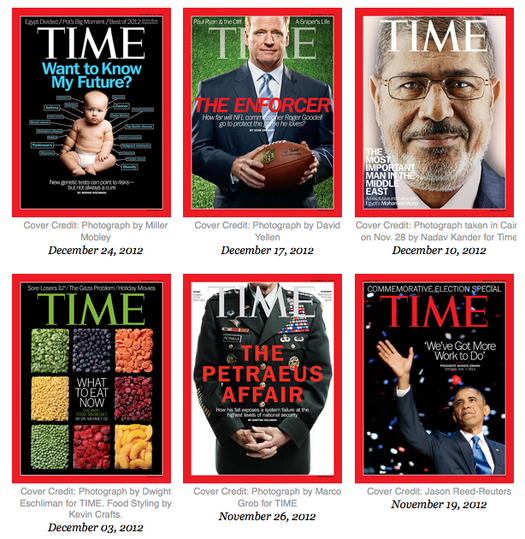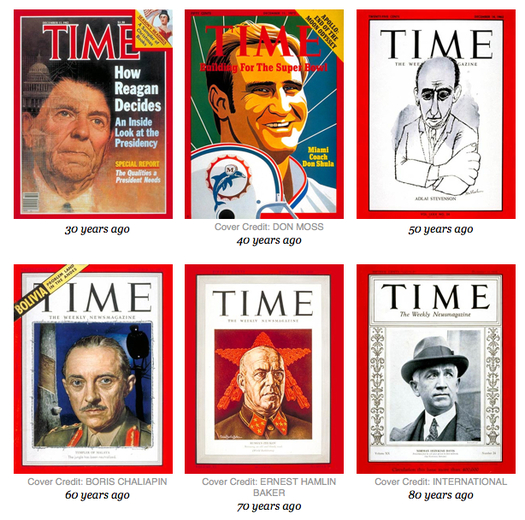The hoo-ha about Instagram, roughly coinciding with Time naming its "person of the year," has reminded me of an event I was puzzling over a couple of months ago: For its Hurricane Sandy cover, Time Magazine selected an image taken via the image-based social network. That sounds like a landmark moment.
But what I was puzzling over was what “the cover of Time Magazine,” as an idea, really means at this point. Once upon a time, of course, it was a declaration: An authoritative statement from the experts about What (or Whom) To Talk About. But how often do you actually see the cover of Time these days, anyway? And what does the magazine’s cover choice communicate to you on any given week? Here from Time’s site are six recent covers:

Recent Time covers, via Time.com
I think I remember noticing that Petraeus cover, but not the others. In general I'd say these covers are either trying to get in on what you were already talking about anyway, or attempts to "go viral," not so much declarations as auditions. Actually the 2012 Time cover I’m most familiar with was the one showing a young mom apparently breast-feeding her three-year-old. That actually did go viral, but from what I can recall the chatter was about the image, rather than the article (something about “attachment parenting,” which sounded like the sort of lifestyle/trend story that I am totally incapable of paying attention to). In other words, the cover was the story, at least in terms of what people reacted to online.
Still, despite all the obvious points that could be made about the struggle for weekly magazine relevance in the nonstop news cycle, I think the idea of the cover of Time remains meaningful — a handy metaphor or bit of shorthand, almost like the informationflow equivalent of a skeumorph.
Maybe that last comparison is a stretch. But it’s clearly easier to complain that some skeumorphs seem dated than in it is to suggest replacement metaphors with the same instant effectiveness. And there’s something similar here: Sure, the days of a Time cover seeming like an importance annointment are pretty much over. But, really, what’s taken its place? Trending topics on Twitter? Buzzfeed’s “Hot On The Web” list?
Okay, so it’s not like Time’s Hurricane Sandy cover suddenly put Instagram on the map, or even affirmed its pervasiveness — the service was clearly already mass, Time itself already had an Instagram account, etc. But on the other hand, people took note specifically because this was a clearly legible marker of something, even it’s something we all pretty much knew.

Older Time covers, via Time.com
Arriving at some kind of replacement for that would involve a consensus not just about what has authority this second, but about what has authority that could plausibly endure. Which brings me back, actually, to the current Instagram hoo-ha. The Sandy picture that Time put on its cover was taken by Benjamin Lowy, who is not a random cameraphone hobbyist, but a pro who happened to use Instagram. Turns out he’s among those who reacted to Instagram’s new terms of service by announcing that — for the moment, at least — he’ll be posting his images elsewhere.
